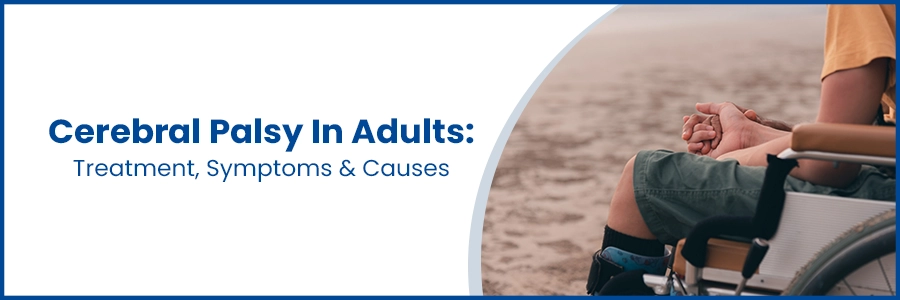- Cardiology 84
- Dermatology 45
- Endocrinology 33
- ENT 16
- Fertility 190
- Gastroenterology 78
- General-Medicine 81
- Gynecology 80
- Hematology 19
- Infectious-Diseases 33
- Neurology 52
- Oncology 34
- Ophthalmology 23
- Orthopedics 69
- Pediatrics 31
- Procedure 23
- Public-Health 144
- Pulmonology 59
- Radiology 8
- Urology 68
- Wellness 161
- Woman-and-child 77

Cerebral Palsy in Adults: Types, Symptoms, Treatment, & Surgery
Cerebral palsy (CP) is a neurological condition that affects movement, muscle tone, and motor skills. While often diagnosed in childhood, CP continues to impact individuals into adulthood, presenting unique challenges that require specialized care and management.
Types of Cerebral Palsy in Adults
Cerebral palsy in adults is classified into several types, each characterized by distinct movement and coordination difficulties:
- Spastic CP: This type causes muscle stiffness and difficulty in movement.
- Athetoid CP: Involuntary and uncontrollable movements are typical.
- Ataxic CP: Affects balance and coordination, resulting in shaky movements.
Symptoms of Cerebral Palsy in Adults
Symptoms of cerebral palsy can vary widely among adults, depending on the type and severity of the condition:
- Muscle weakness and imbalance: Difficulty in controlling muscles, impacting mobility.
- Spasticity: Muscle stiffness that can lead to joint contractures.
- Speech and communication difficulties: Challenges in verbal expression and understanding.
- Coordination issues: Difficulty in precise movements and maintaining balance.
Treatment Options for Adults with Cerebral Palsy
Managing cerebral palsy in adults involves a multidisciplinary approach aimed at enhancing mobility and function:
- Physical Therapy: Focuses on improving muscle tone, flexibility, and motor skills.
- Medications: Help manage spasticity, pain, and other related symptoms.
- Speech and Occupational Therapy: Address communication challenges and daily living skills.
- Orthopedic Interventions: Surgical procedures to correct skeletal deformities or improve mobility.
Ready to take control of your health journey? Book your appointment now and start your path towards wellness today!
Book an AppointmentSurgical Interventions for Cerebral Palsy in Adults
In some cases, surgical procedures may be recommended to address severe symptoms or complications:
- Orthopedic Surgeries: Corrects bone and joint deformities to improve mobility and function.
- Selective Dorsal Rhizotomy (SDR): Targets spasticity by severing nerve roots.
- Tendon Lengthening: Improves muscle function and range of motion.
- Functional Surgeries: Enhances specific abilities, such as walking or hand function.
Conclusion
Understanding the complexities of cerebral palsy in adults from its types and symptoms to treatment options and surgical interventions is crucial for providing effective care and support. By combining medical expertise with personalized therapies, adults with cerebral palsy can achieve improved quality of life and greater independence in managing their condition.
Frequently Asked Questions
Yes, cerebral palsy can affect individuals throughout their lives, including adulthood, although it is more commonly associated with childhood.
Cerebral palsy cannot be cured, but treatments and therapies can help manage symptoms and improve quality of life for adults with the condition.
Some individuals with cerebral palsy can walk independently, while others may require mobility aids or assistance, depending on the severity of their condition.
Cerebral palsy doesn't have a specific age limit. It's a lifelong condition that begins in early childhood and continues into adulthood.
Yes, some individuals with cerebral palsy can experience pain due to muscle stiffness, spasms, and other related issues.
Yes, adults with cerebral palsy can communicate, but some may experience speech difficulties due to muscle control issues.
Yes, cerebral palsy is often caused by brain damage that occurs before, during, or shortly after birth, affecting muscle control and coordination.
Surgery can help manage specific issues associated with cerebral palsy, such as correcting joint deformities or improving mobility, but it cannot cure the underlying condition.
While cerebral palsy is a lifelong condition, early intervention and proper treatments can significantly improve mobility, communication, and overall quality of life.
Brain surgery is not a common treatment for cerebral palsy. Surgical interventions typically focus on managing specific symptoms or complications, such as muscle spasticity or joint issues.

- Cardiology 2132
- Dermatology 168
- Endocrinology 135
- ENT 97
- Fertility 217
- Gastroenterology 232
- General 478
- General-Medicine 1685
- Gynecology 169
- Hematology 85
- Infectious-Diseases 208
- Neurology 207
- Oncology 345
- Ophthalmology 65
- Orthopedics 187
- Pediatrics 83
- Procedure 72
- Public-Health 209
- Pulmonology 126
- Radiology 13
- Second Opinion 311
- Urology 294
- Wellness 600
- Woman-and-child 447
- Others 10217
Related Blogs
If you have any questions, please fill out the enquiry form or call us, and we will get back to you promptly.
040-68334455